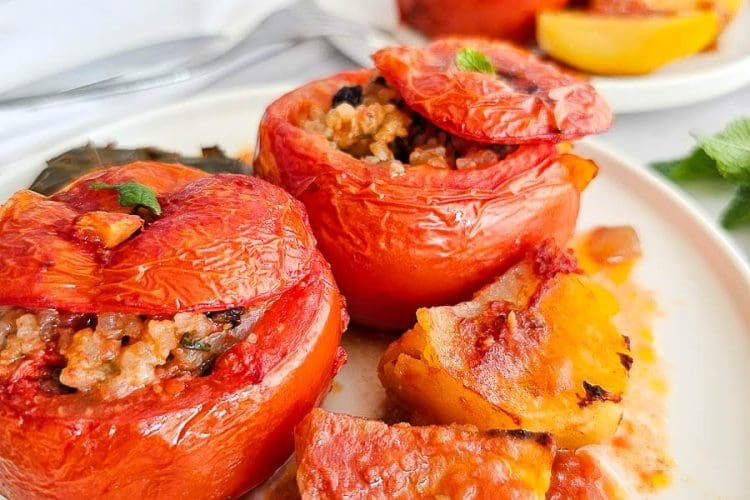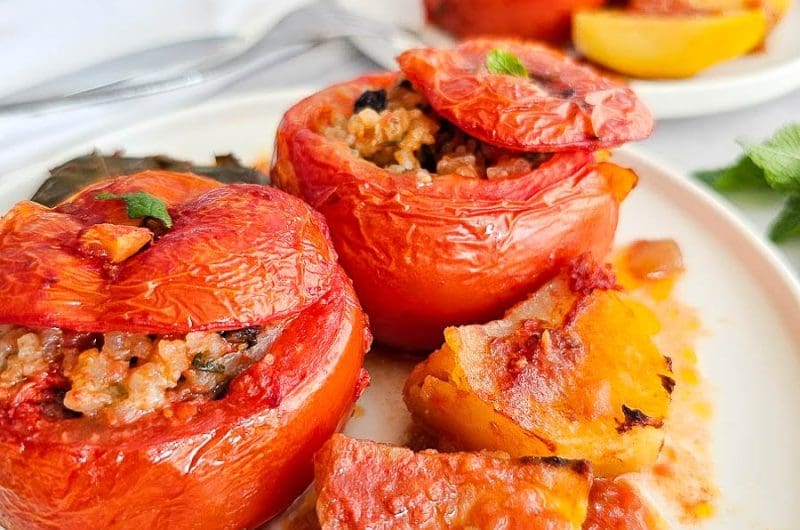If you haven’t experienced the Greek Stuffed Tomatoes with Rice (Yemista), you’re in for a delightful surprise. This wholesome combination of tomatoes, rice, potatoes and fresh herbs, baked in a rich tomato and olive oil sauce, will have you lining up for seconds.
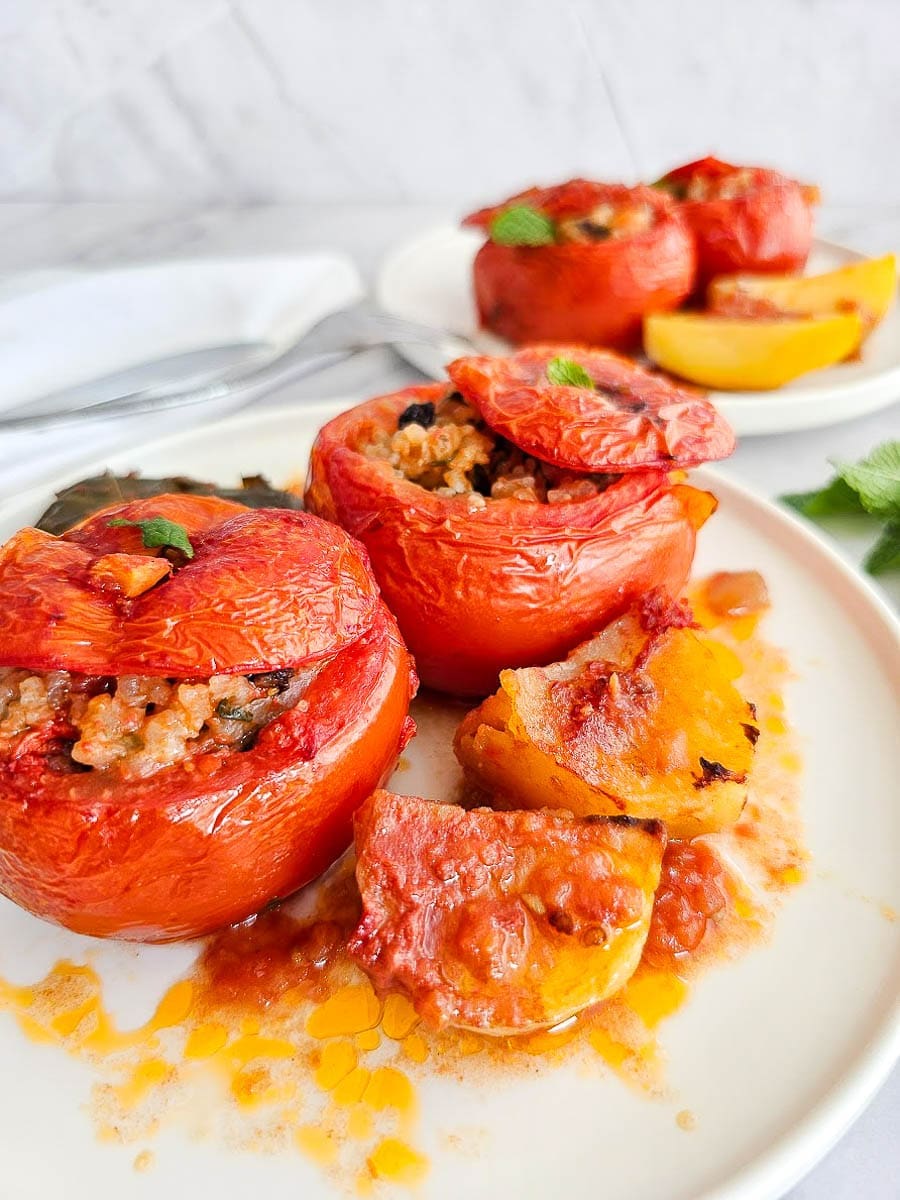
Greek Stuffed Tomatoes with Rice (Yemista / Gemista) are full of flavour and showcase the essence of the Mediterranean diet. Every family has its unique take on this recipe, and what you find here is my mother’s and my aunt’s rendition of Yemista. I always looked forward to dining at my aunt’s house, as I knew that I was going to love her food just as much as my mum’s, as they had a very similar style of cooking.
Whenever my mum told us she was making ‘Yemista’ for dinner, our first question would be ‘with mince or without?’ Some of us would be pleased with her response and others, not so much. The reason being is that we all had a preference. However, if my mum was making this dish during lent, we knew that it definitely had no meat. Growing up, I much preferred the Yemista with meat, but now I can’t decide, as I find them both delicious.
What is Yemista?
Yemista (which in Greek means ‘filled with’) is a traditional Greek dish, consisting of vegetables, often tomatoes and capsicum/bell peppers, eggplant and zucchini/courgette, hollowed out and stuffed with a delicious mixture of rice, herbs, and occasionally, ground meat. The stuffing in this recipe includes rice, onions, and fresh herbs such as parsley and mint, creating a flavourful and aromatic blend. The stuffed vegetables are then baked until tender. As the dish bakes, the tomatoes release their juices, creating a delicious sauce that infuses the surrounding potatoes. The result is a satisfying dish that highlights the fresh flavours of the Mediterranean. In this recipe, I am only filling tomatoes, although you can also fill capsicum/peppers, eggplant and zucchini.
Vegetarian, Vegan and Gluten-Free
This version of Yemista is free of animal products, making it an excellent choice for those following a vegan lifestyle! It is also gluten-free, making it an ideal choice for individuals following a gluten-free diet.
There are many different vegetables that can be filled, and so many types of fillings, however, this combination of rice, onion, currants, and fresh herbs, baked in a rich tomato and olive oil sauce, would have to be my favourite.
Greek Stuffed Tomatoes with Rice (Yemista) Ingredients
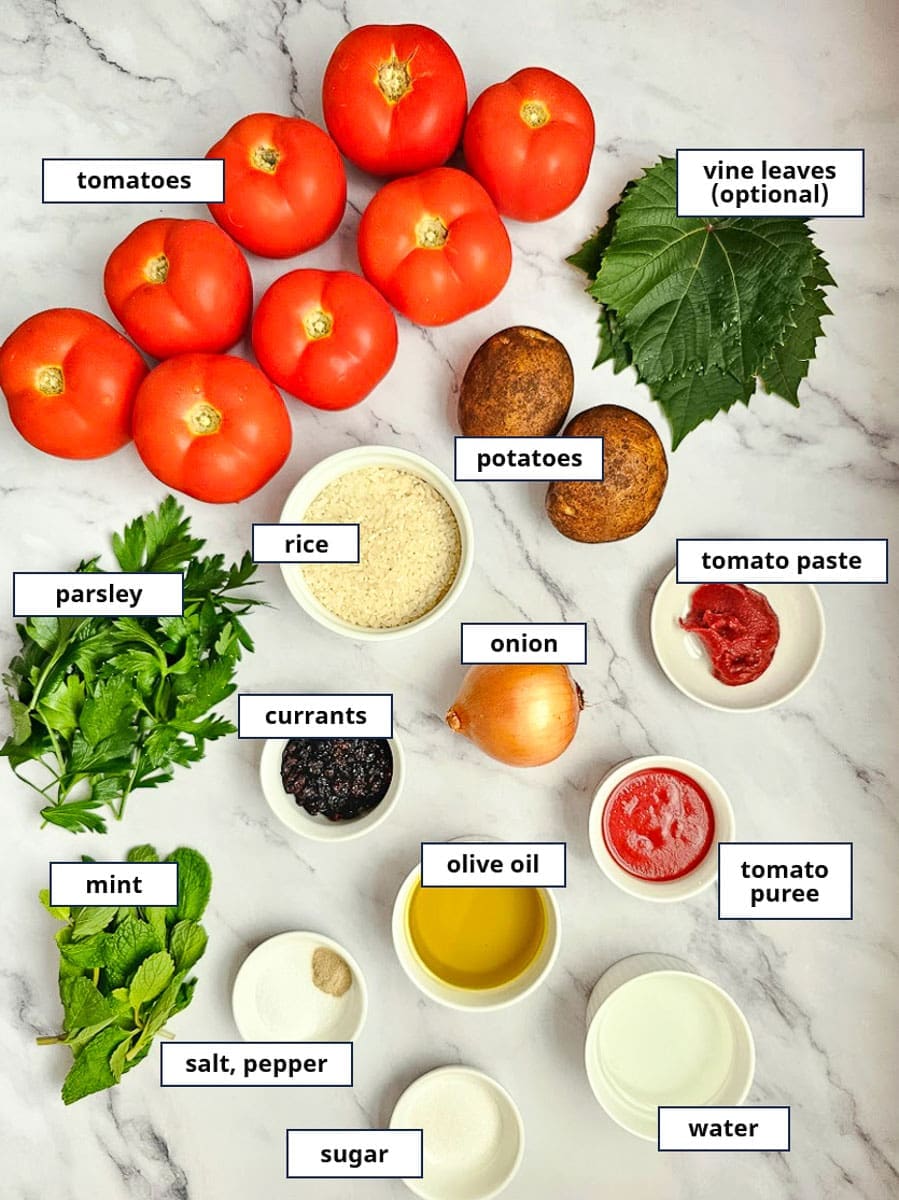
- Tomatoes: Choose large, firm tomatoes as they are easier to fill. You also want them to be ripe because they are sweeter and juicier. I usually find larger tomatoes at the local greengrocer.
- Onions: I use brown onions, but you can use red if you prefer. Let them sweat so that they develop a nice, sweet flavour.
- Rice: The type of rice traditionally used in Yemista is medium-grain rice. This type of rice is preferred because it tends to absorb flavours well and becomes tender during the baking process, contributing to the overall texture and taste of the stuffed vegetables. You can use brown rice, but this will take a little longer to cook.
- Olive oil: Only use extra-virgin olive oil and be generous with the amount you use. Along with the juices of the tomato, it’s what really gives these stuffed tomatoes their rich, deep flavour and contributes to a juicy filling, rather than a dry filling with hard bits of rice.
- Parsley and mint: The addition of herbs elevates the flavour of the filling, making the Yemista super tasty.
- Currants: My mum adds currants to her Yemista (not raisins or sultanas, as they have a sweeter taste and are smaller). Currants add sweetness to the dish, along with a subtle burst of flavour.
- Potatoes: Slow roasting the potatoes in the tomato juice allows them to absorb the rich flavours of the tomatoes. I like to use potato varieties with a starchy texture as they become fluffy on the inside and crispy on the outside when cooked. Some suggestions for potatoes include:
| Country | Potatoes ideal for baking |
| Australia | Sebago (brushed potatoes), Royal Blue, Otway Red |
| US, Canada | Russet, Kennebec, Yukon Gold |
| UK | King Edward, Maris Piper |
| New Zealand | Agria, Otway Red |
| Europe | Bintje, King Edward, Desiree |
| Asia | May Queen, Agria, Danshaku |
| Africa | Mondial, Sifra |
- Vine leaves (optional): If you are lucky enough to grow your own or have a family member or neighbour who grows them, fresh vine leaves taste nicer than the packaged vine leaves. I have included steps on how to prepare vine leaves in the notes section below.
Ingredients for the sauce
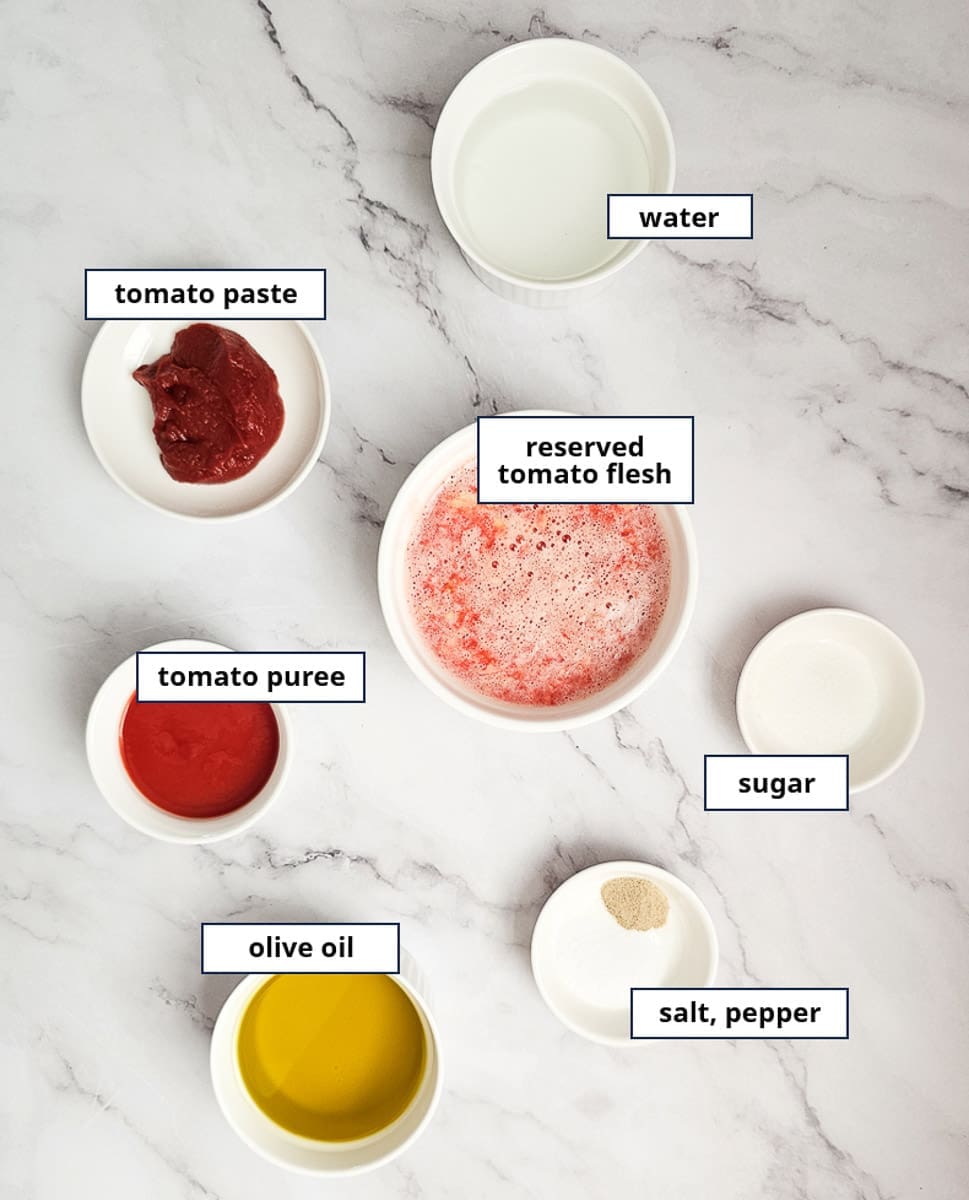
Health benefits of Greek Stuffed Tomatoes with Rice (Yemista)
Yemista offers a range of health benefits attributed to its nutrient-rich components. The tomatoes provide a rich source of antioxidants, particularly lycopene, renowned for its potential in combatting oxidative stress and promoting heart health. The inclusion of olive oil introduces heart-healthy monounsaturated fats, aligning with the positive impact of the Mediterranean diet on cardiovascular well-being. Rice provides a complex carbohydrate source, dietary fibre for digestive health and supports brain function.
Additionally, incorporating potatoes contributes essential vitamins and minerals such as vitamin C and potassium, crucial for immune function and blood pressure regulation. Parsley and mint bring a wealth of vitamins and antioxidants, aiding in digestion and overall health. Currants, with their natural sweetness and dietary fibre, enhance digestive health, are a good source of potassium for nerve and muscle function, and contain a variety of antioxidants. Overall, Yemista is a nourishing dish that is not only tasty, but provides a range of nutrients that promote overall well-being.
How to make Greek Stuffed Tomatoes with Rice (Yemista)
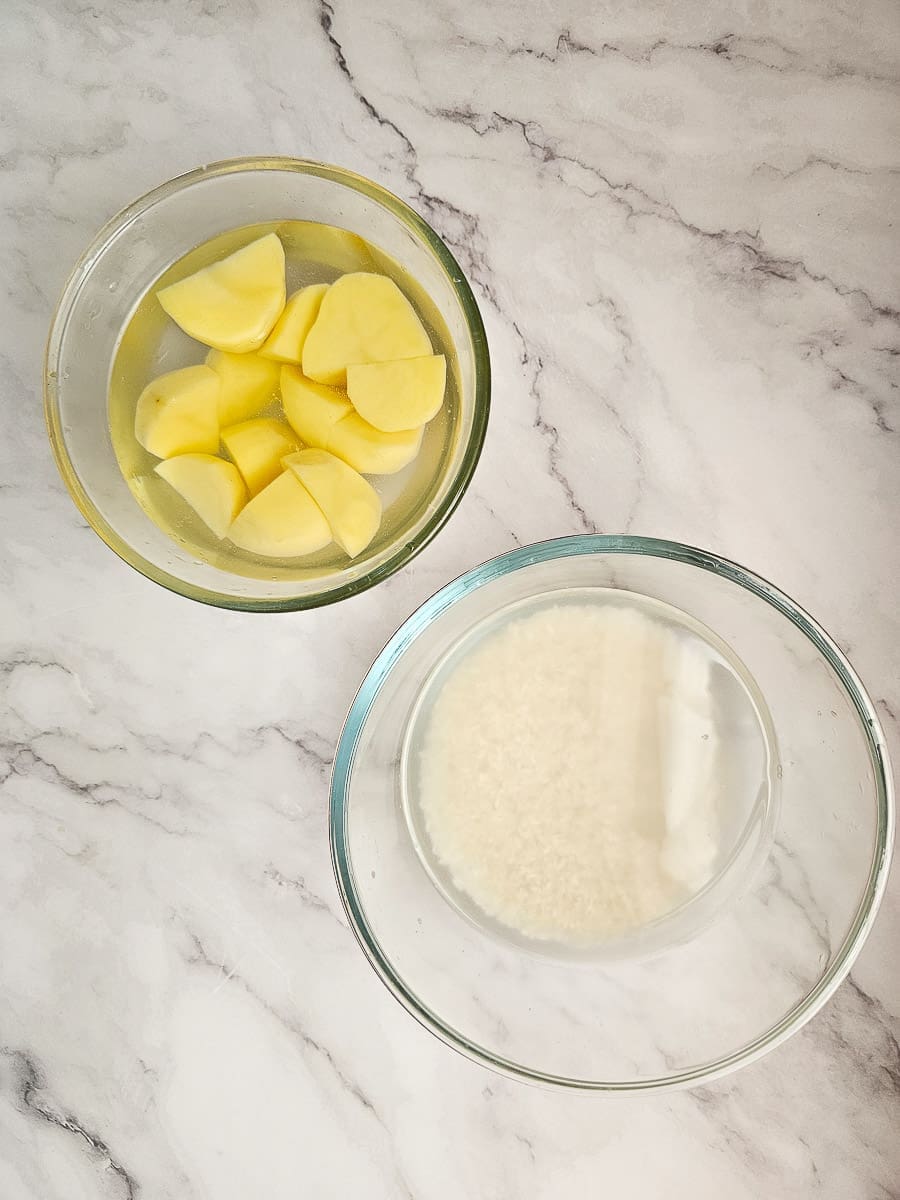
1. Wash the rice thoroughly, then place it in a bowl, and cover it with water. Soak for 15 minutes. Strain. Peel potatoes and cut into wedges. Place in a bowl and cover with water.
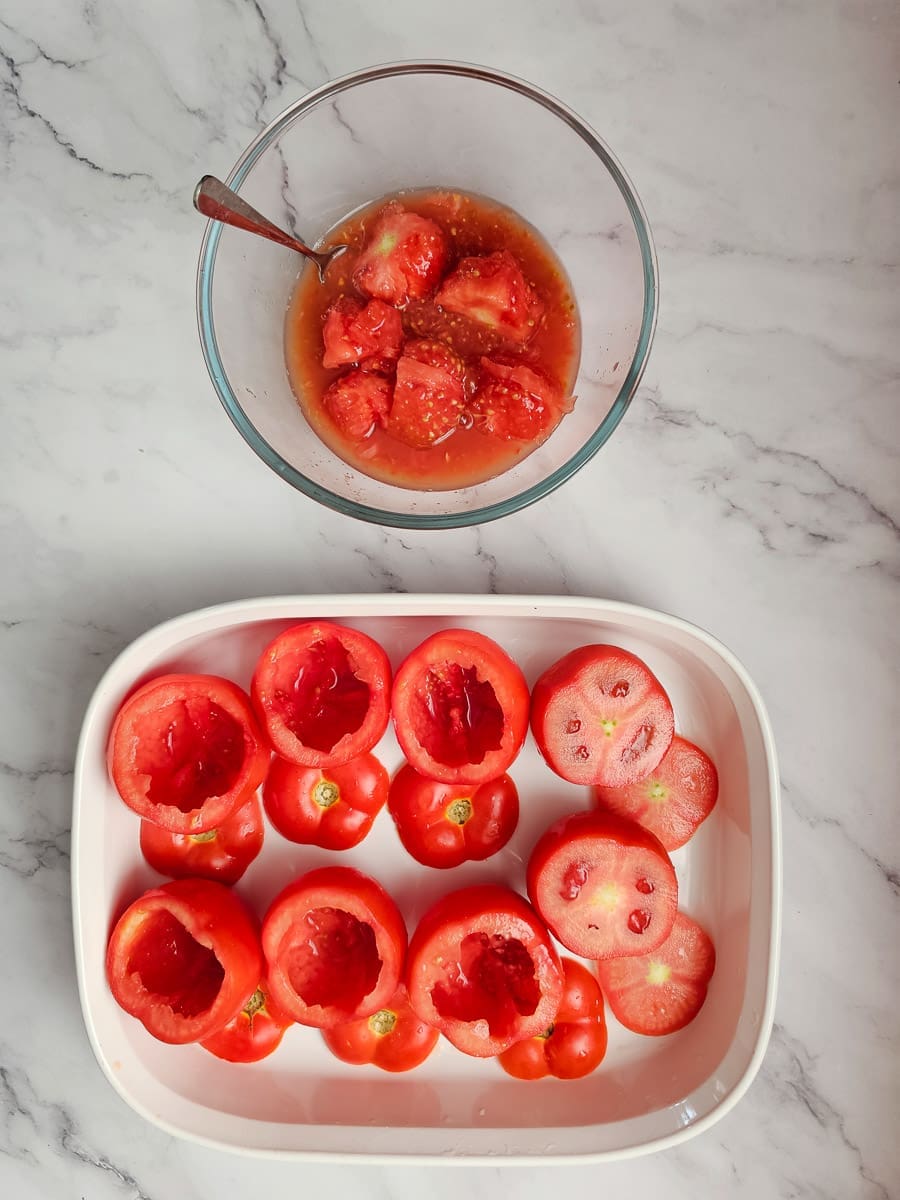
2. Slice the tops of the tomatoes, about 1cm/½ inch from the top and set aside. Using a teaspoon, scoop out the tomato pulp and reserve in a bowl. Be careful not to pierce through the skin of the tomatoes.
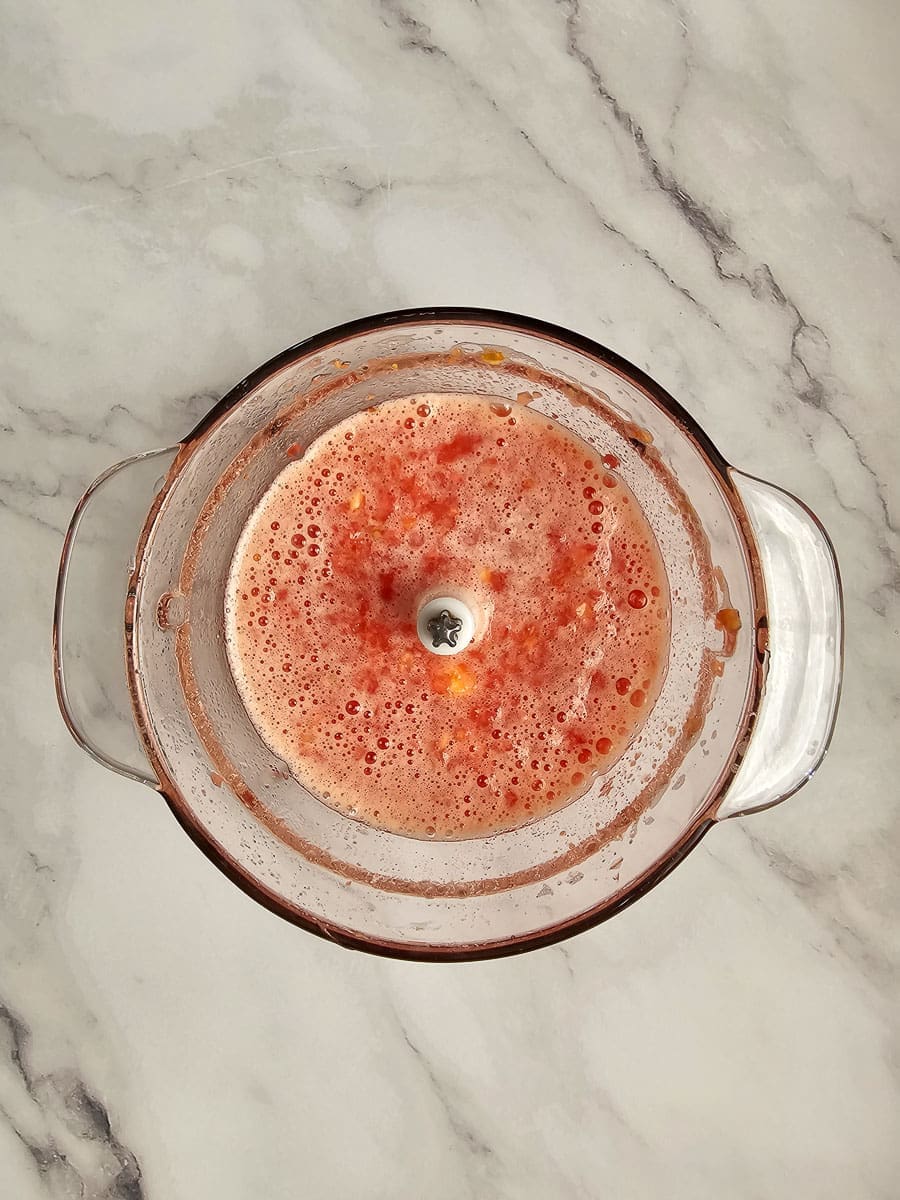
3. Place all the tomato pulp in a food processor and blend till smooth. Set aside.
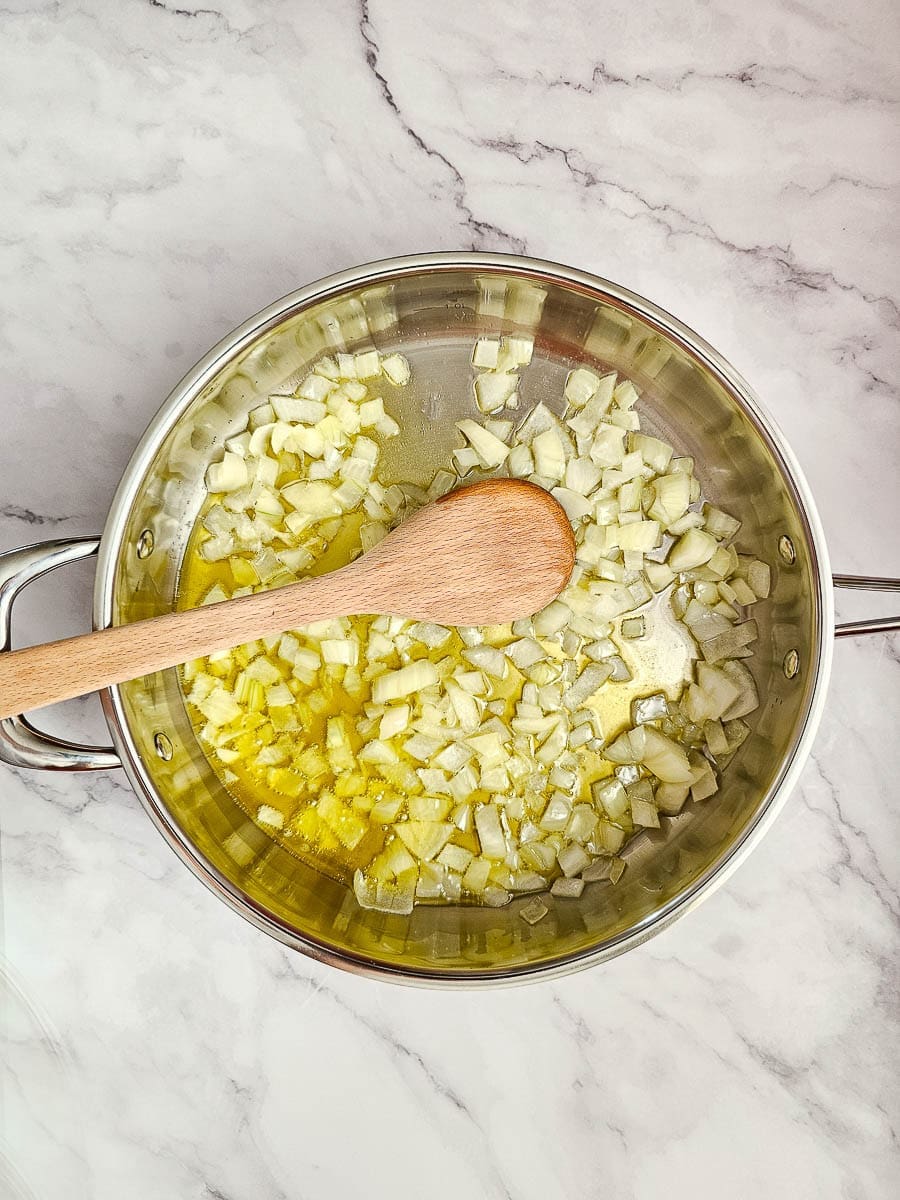
4. In a frying pan, heat oil. Add diced onion. Cook until the onion is soft and transparent.
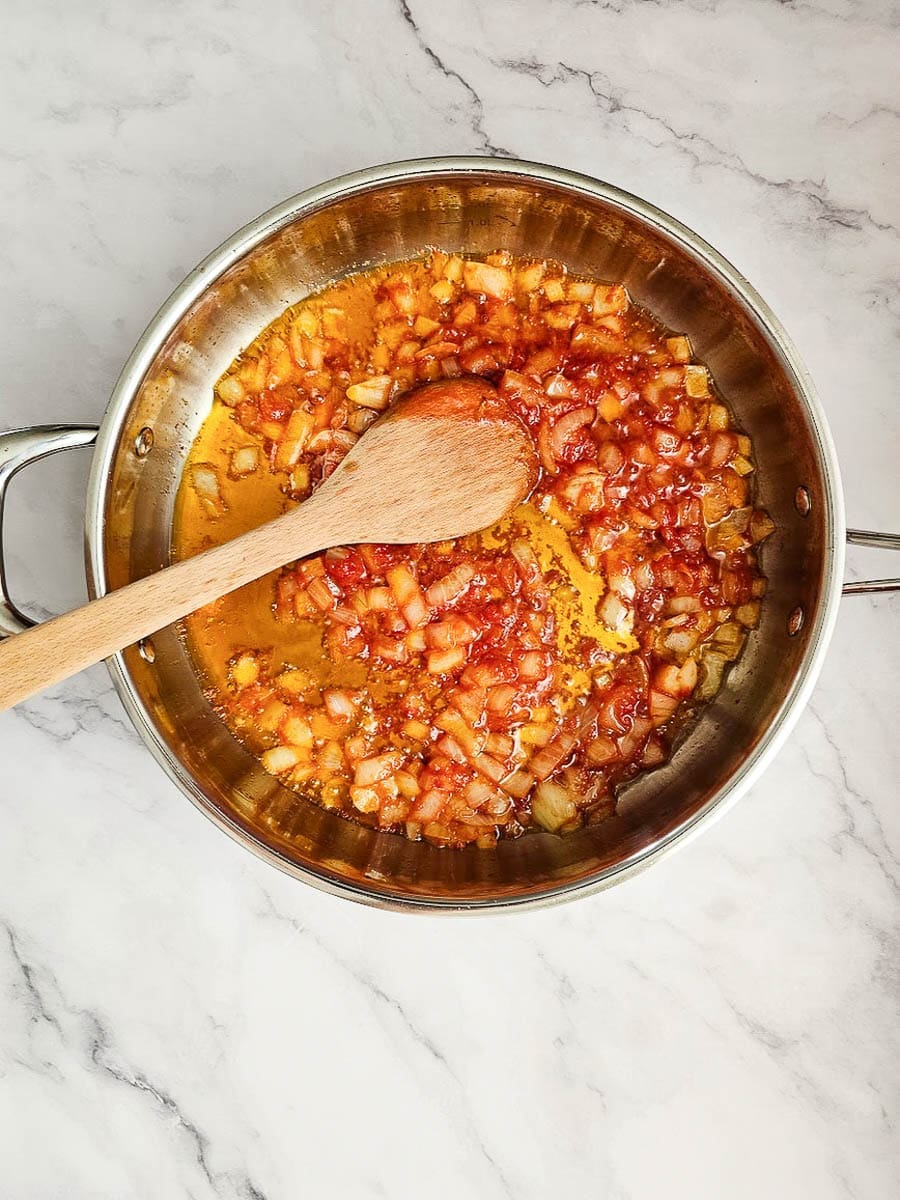
5. Add tomato paste and tomato puree. Stir for 2 minutes.
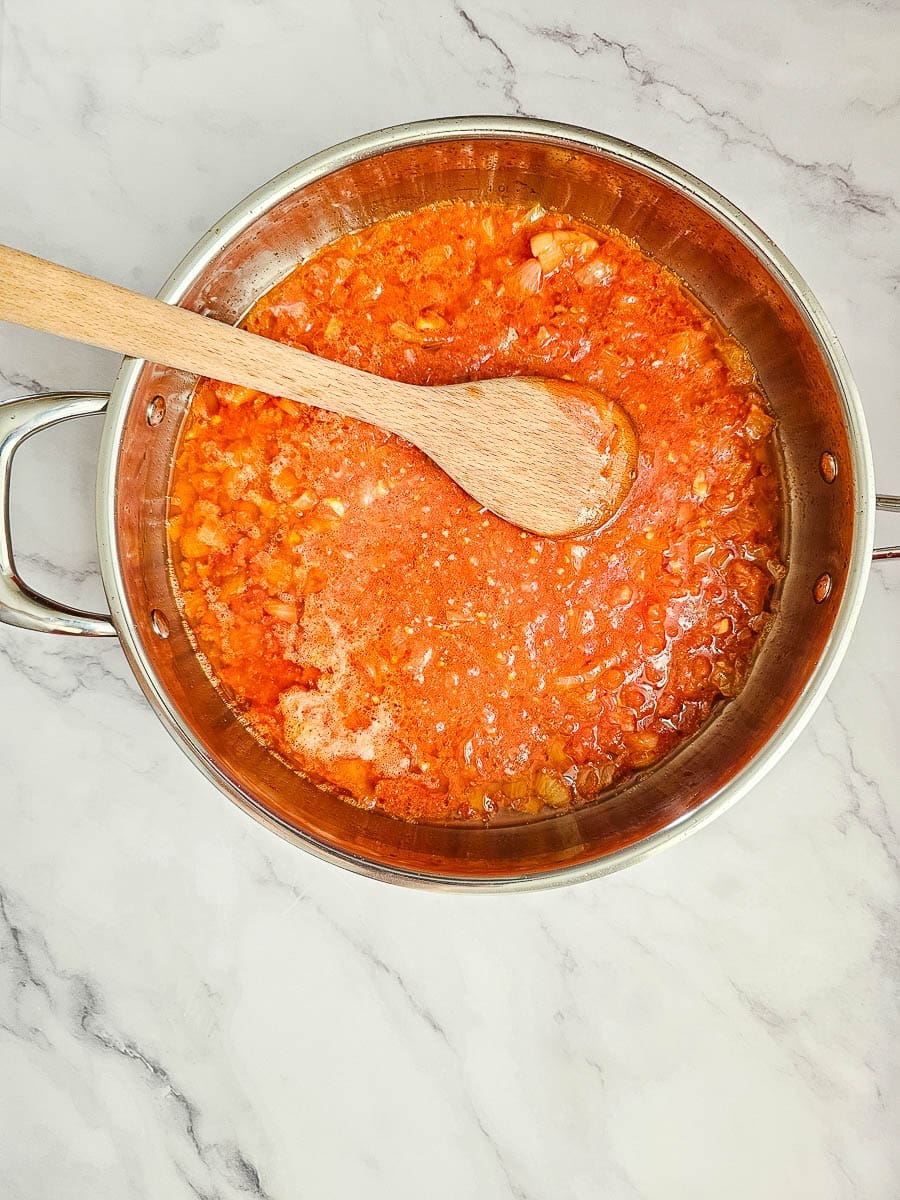
6. Add half of the pureed tomato pulp. Set aside the other half for the sauce.
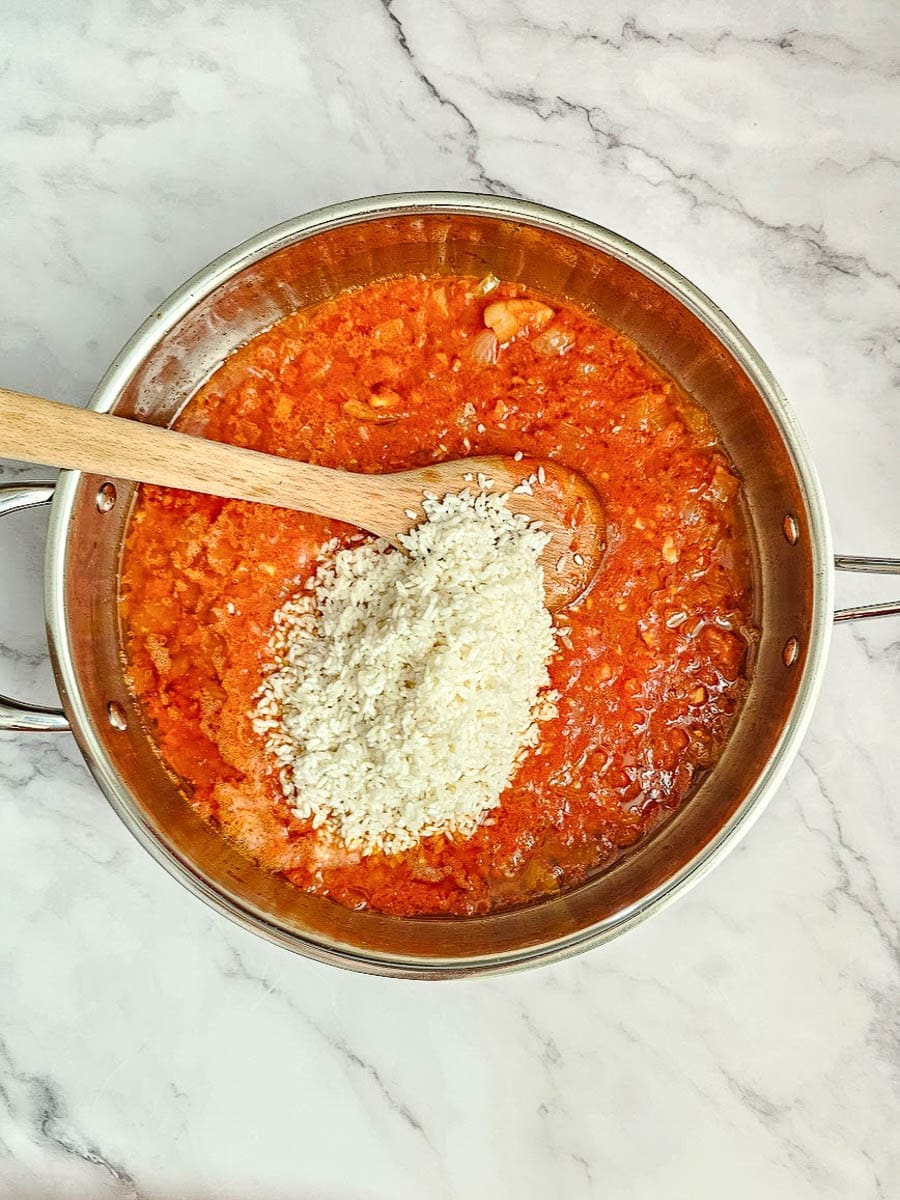
7. Add the rice, water, sugar, salt and pepper and continue sauteing for another 5-6 minutes or until most of the sauce has evaporated. It doesn’t need to cook throughout as the rice will continue to cook in the oven.
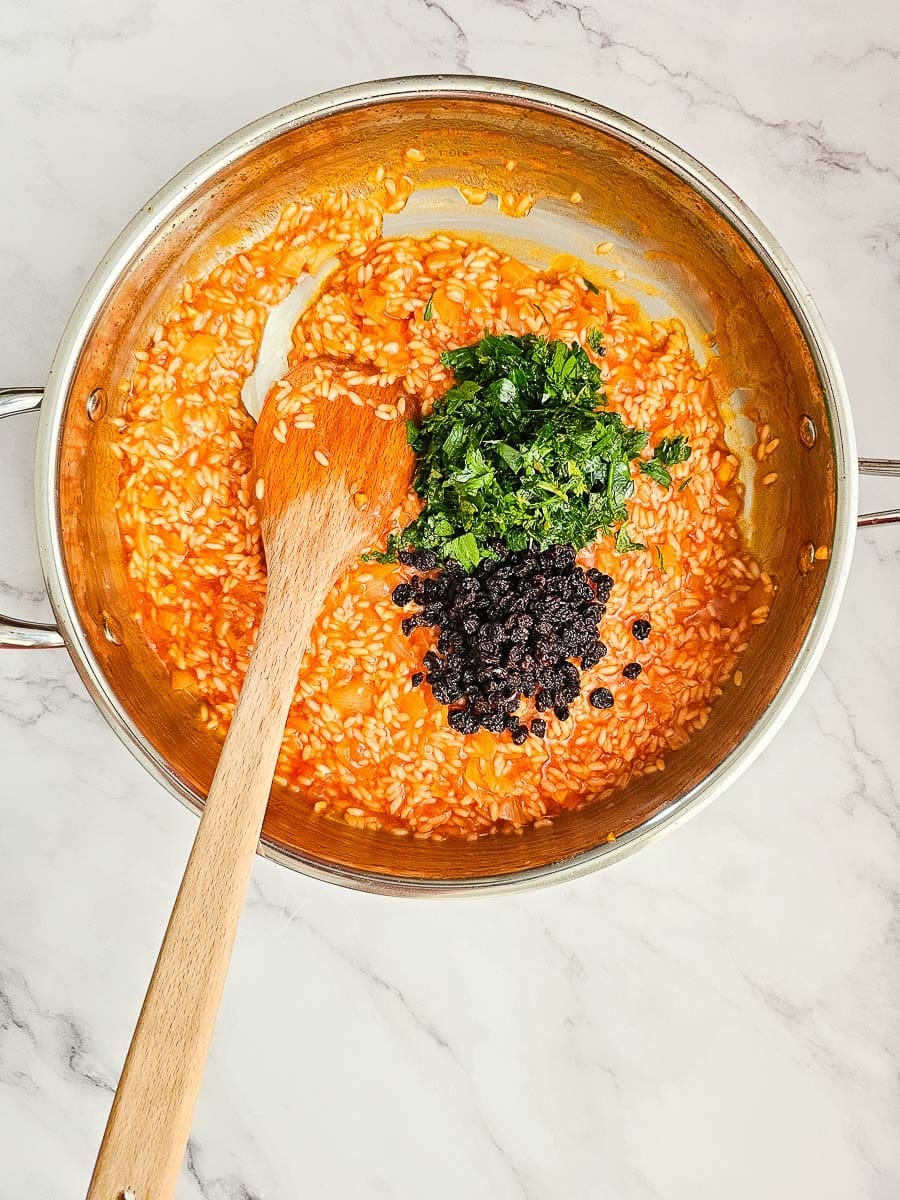
8. Remove from the heat and stir through chopped parsley, mint, and currants. Set mixture aside in a bowl to cool slightly.
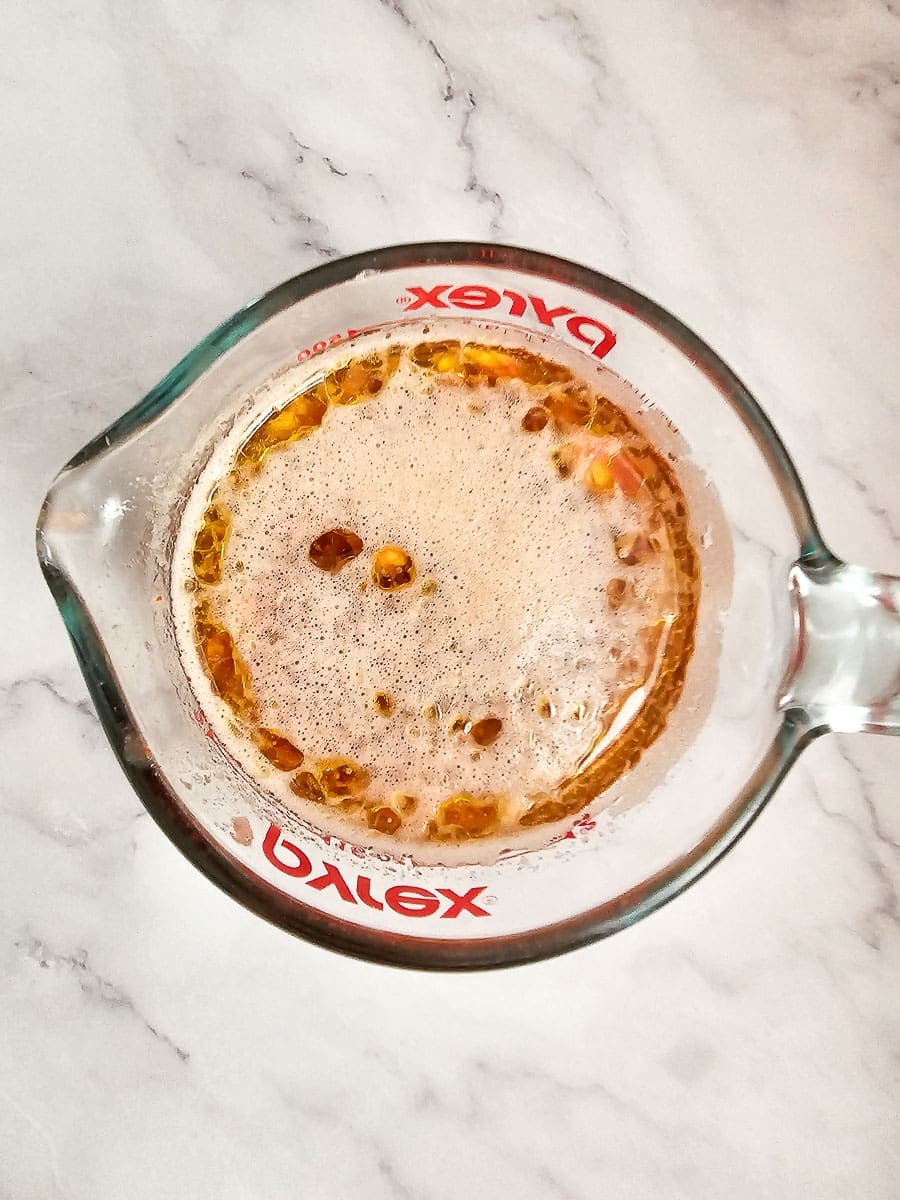
9. To prepare tomato sauce: In a bowl, mix together reserved pureed tomato pulp tomato paste, tomato puree, sugar, olive oil, water, salt and pepper.
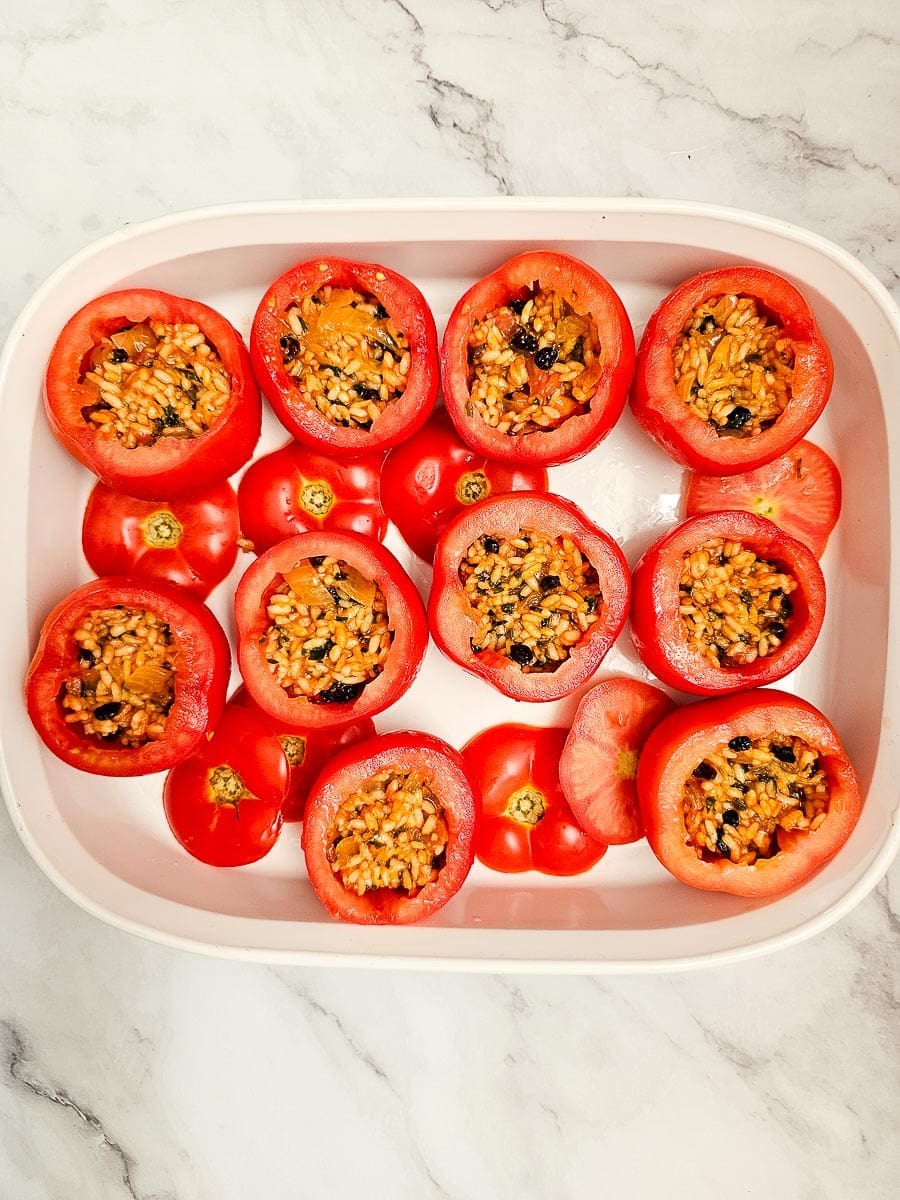
10. Add a little salt to the inside of each tomato. Fill the tomatoes just below the rim. Place lid on top of each tomato. Avoid overfilling the tomatoes to prevent them from splitting too much when baked.

11. Drain potatoes and arrange potatoes in baking dish in between tomatoes. Add a little extra salt over the potatoes. Add vine leaves, if using.
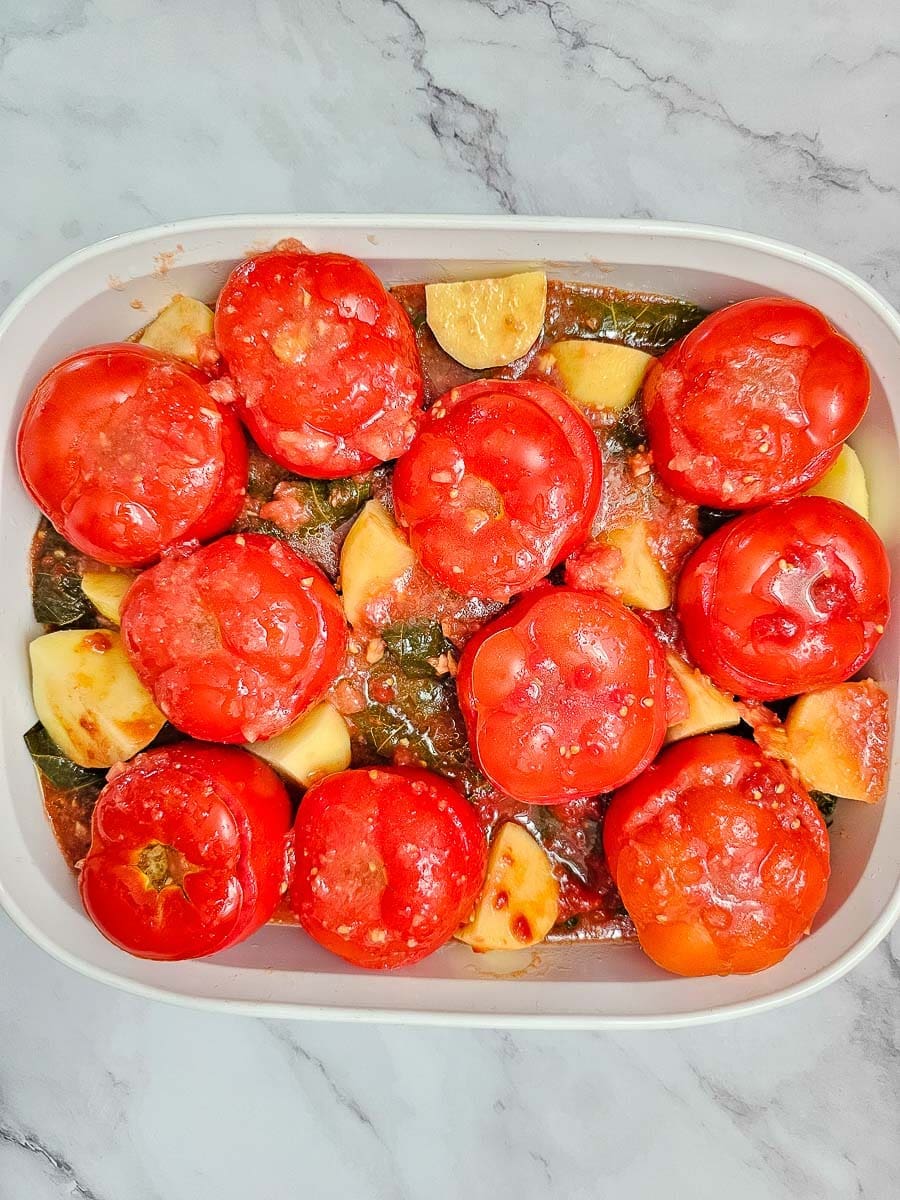
12. Pour tomato mixture over tomatoes, vine leaves and potatoes.
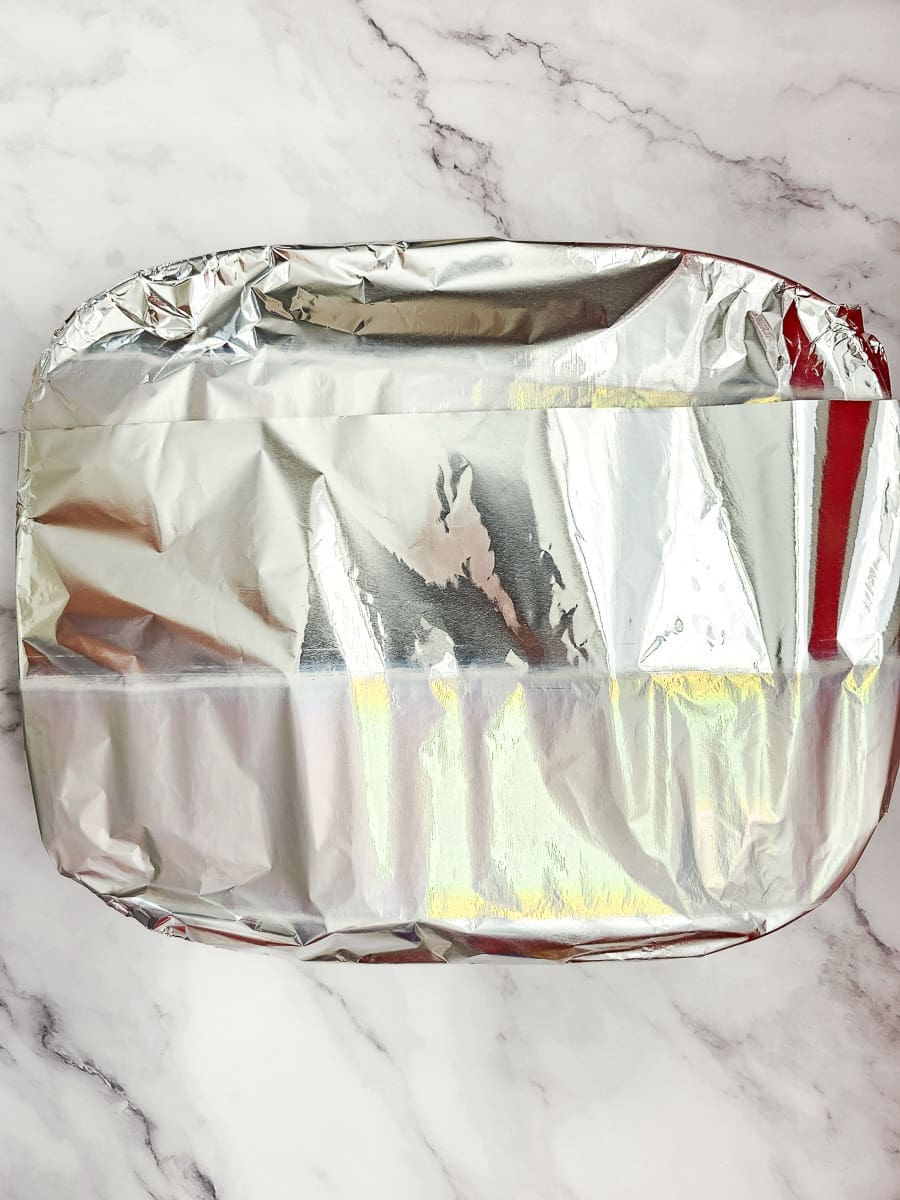
13. Cover baking dish tightly with foil and bake for 45 minutes. Then, remove foil and bake for a further 30-35 minutes, or until rice and potatoes are cooked. Add extra water during cooking if needed.
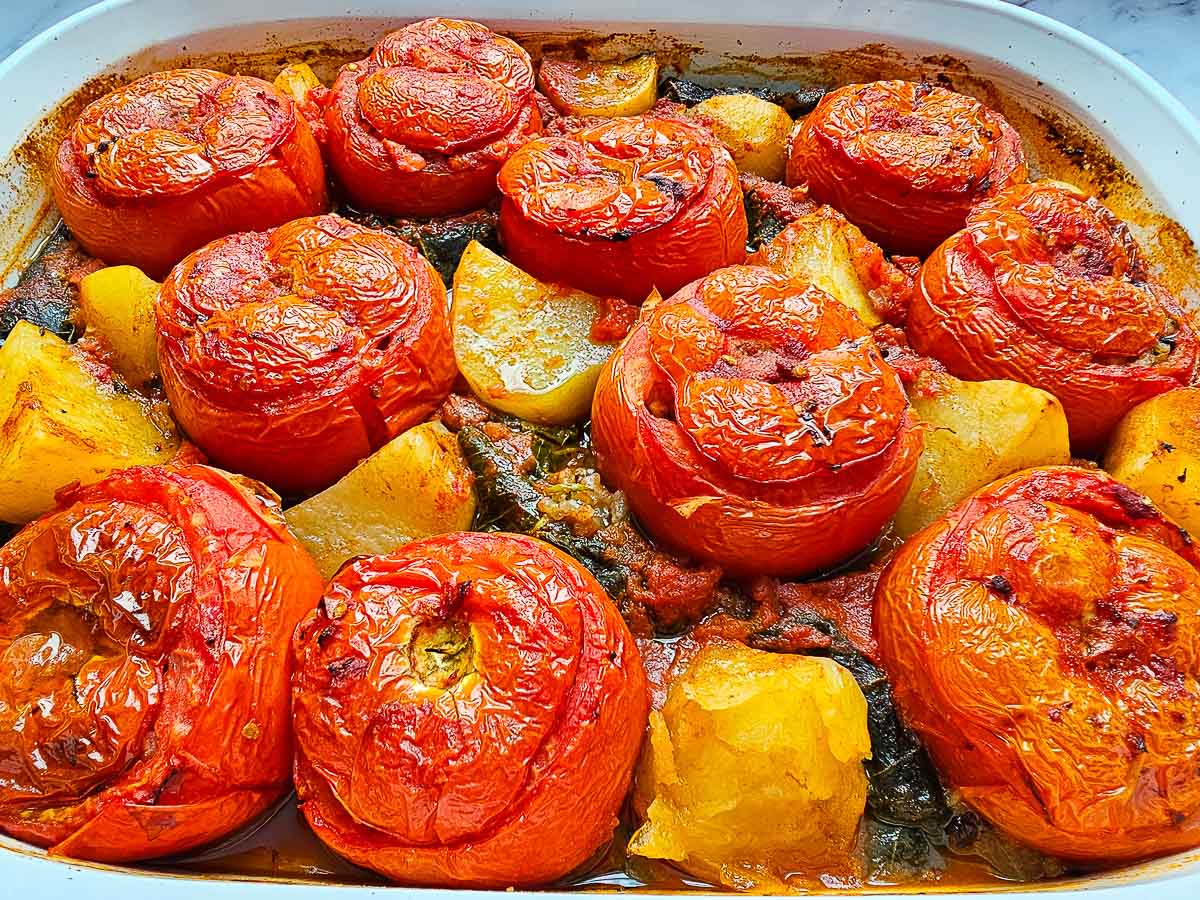
14. Remove from the oven and let cool for 10 minutes to soak up the juices and for the sauce to thicken slightly.
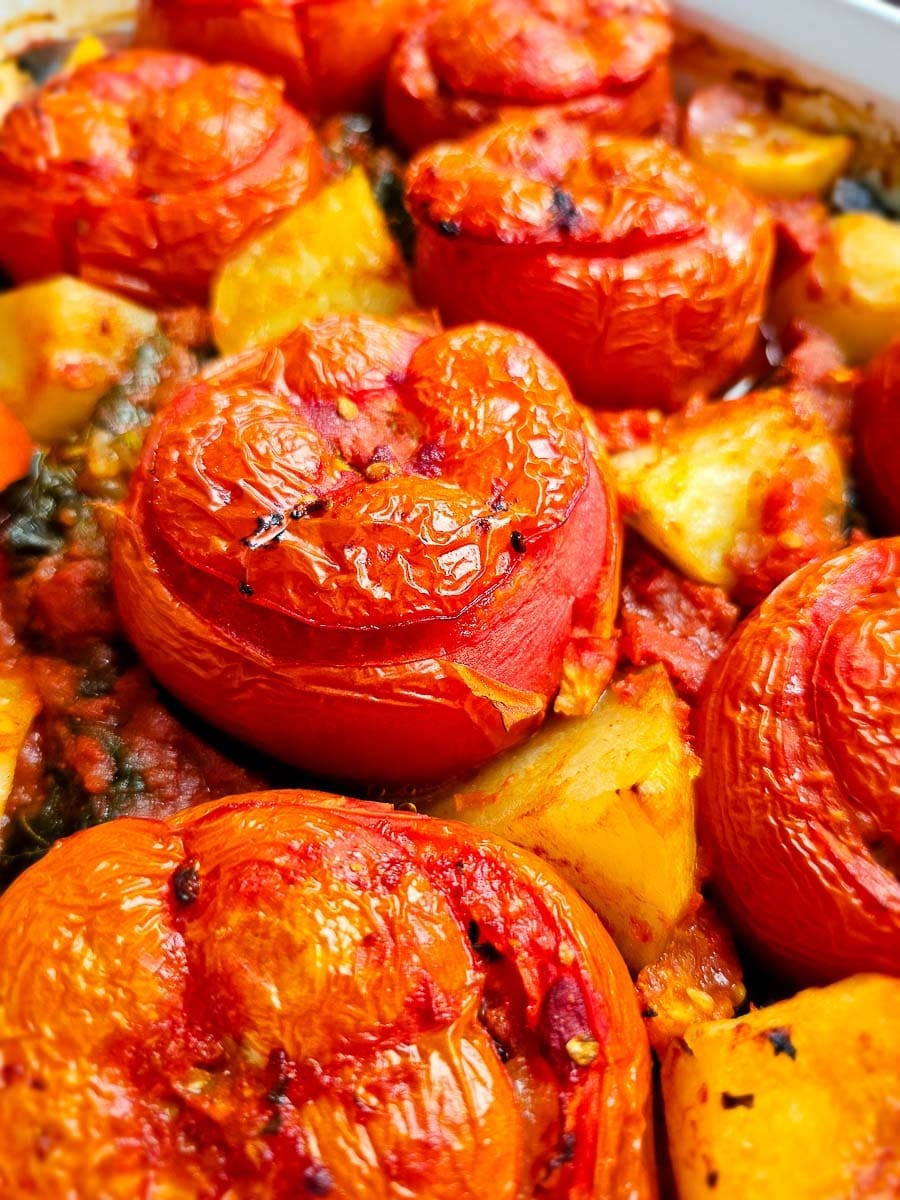
Vine leaves – everything you need to know
If you are lucky enough to grow your own or have a family member or neighbour who grows them, fresh vine leaves taste nicer than the packaged vine leaves. Packaged vine leaves are typically preserved in brine or vinegar, and this significantly alters their flavour, giving them a salty, bitter taste. Fresh vine leaves are typically available seasonally in specialty markets, farmers’ markets, or ethnic grocery stores.
Packaged vine leaves are more widely available and can be found in the international or Mediterranean food sections of many grocery stores.
To prepare vine leaves:
- If using fresh vine leaves, bring saucepan of water to boil. Add a little salt and a teaspoon of oil. Blanch fresh vine leaves for approximately 1-2 minutes.
- If using packaged vine leaves, rinse well. Blanch vine leaves for 1-2 minutes to reduce bitterness. Rinse in cold water. Taste a small piece. If they still taste bitter, you can repeat the blanching process.
To freeze fresh vine leaves:
Freezing fresh vine leaves allows me to have them on hand throughout the year.
- Select fresh vine leaves and wash them.
- Blanch the leaves in boiling water for 1-2 minutes.
- Strain and pat dry the vine leaves.
- Transfer the frozen leaves to freezer bags or containers. Label and freeze.
- To use, thaw in the refrigerator overnight or in cold water.
To fill and roll vine leaves:
- Lay a vine leaf on a flat surface with the shiny side facing down.
- Spoon 1 teaspoon of the filling onto the bottom end (stem end) of the leaf. Do not overfill the vine leaf as the rice will expand during cooking.
- Fold the lower section of the leaf over the filling towards the centre.
- Bring the two sides of the leaf in towards the centre and roll them up tightly.
- Place the stuffed vine leaves in the baking dish (folded side facing down) with the tomatoes.
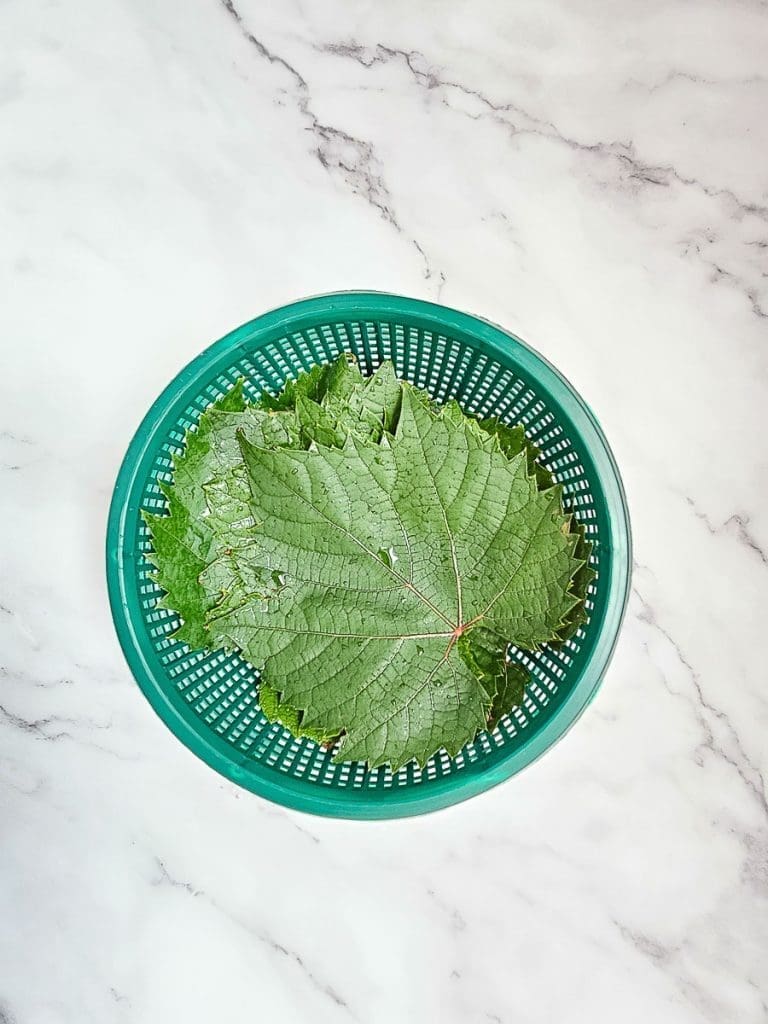
1. Select fresh vine leaves and wash them.
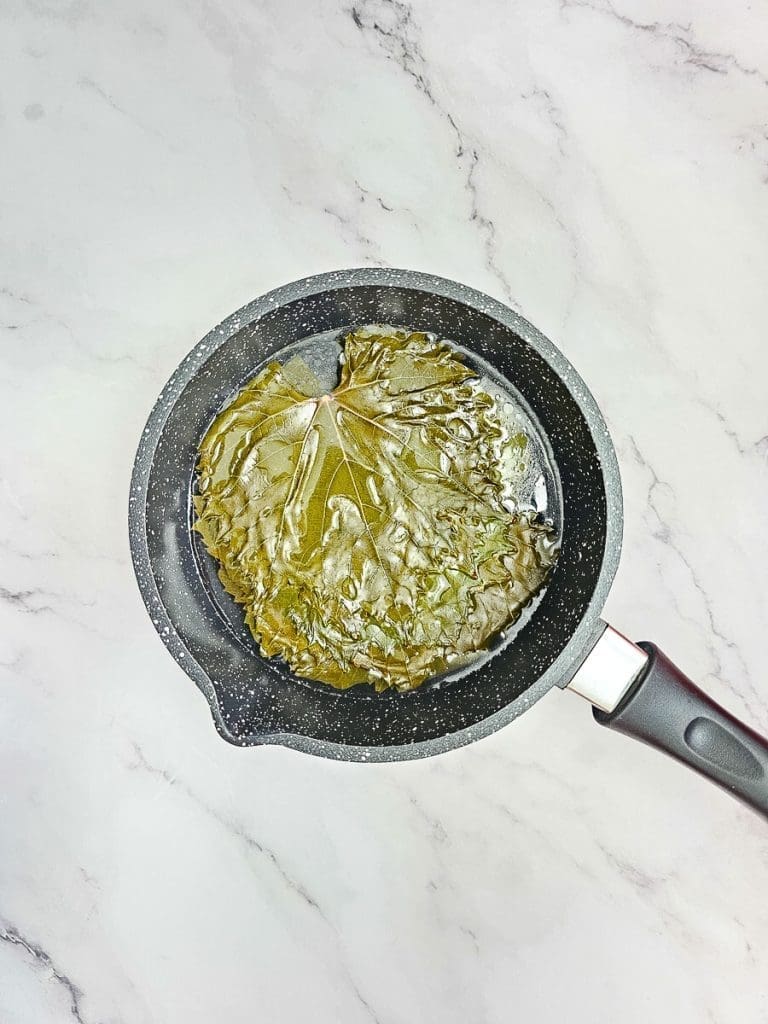
2. Blanch the leaves in boiling water for 1-2 minutes.
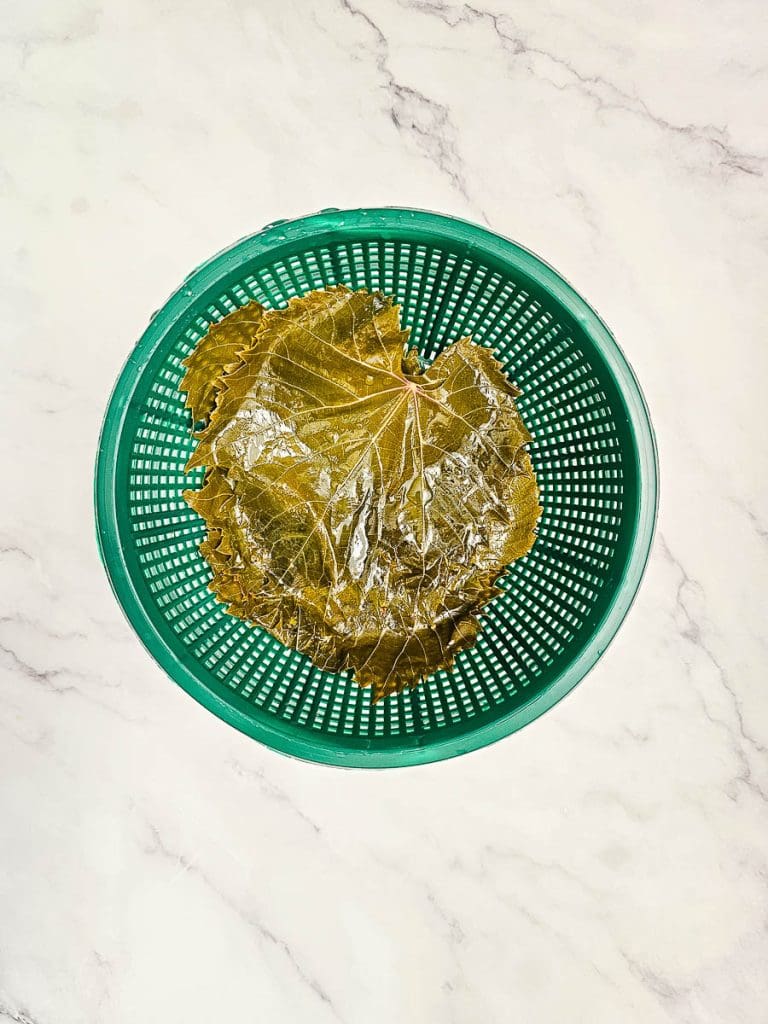
3. Strain and pat dry the vine leaves.

4. With shiny side of leaf facing down, spoon 1 teaspoon of rice mixture onto bottom end of the leaf.
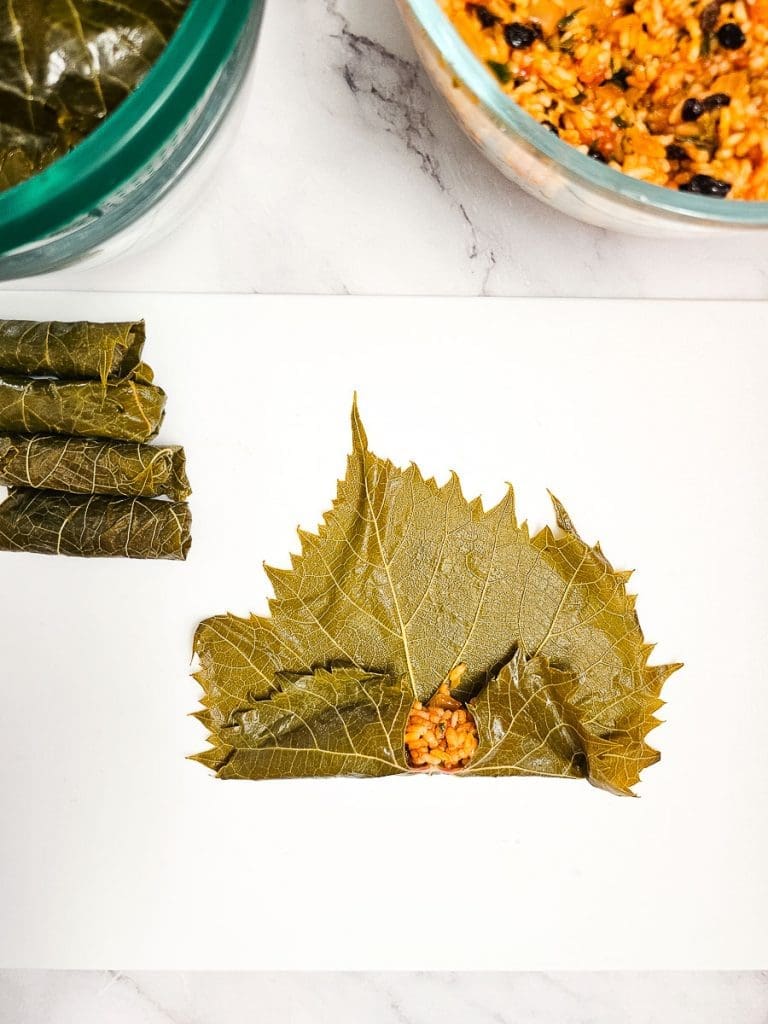
5. Fold the lower section of the leaf over the filling towards the centre.
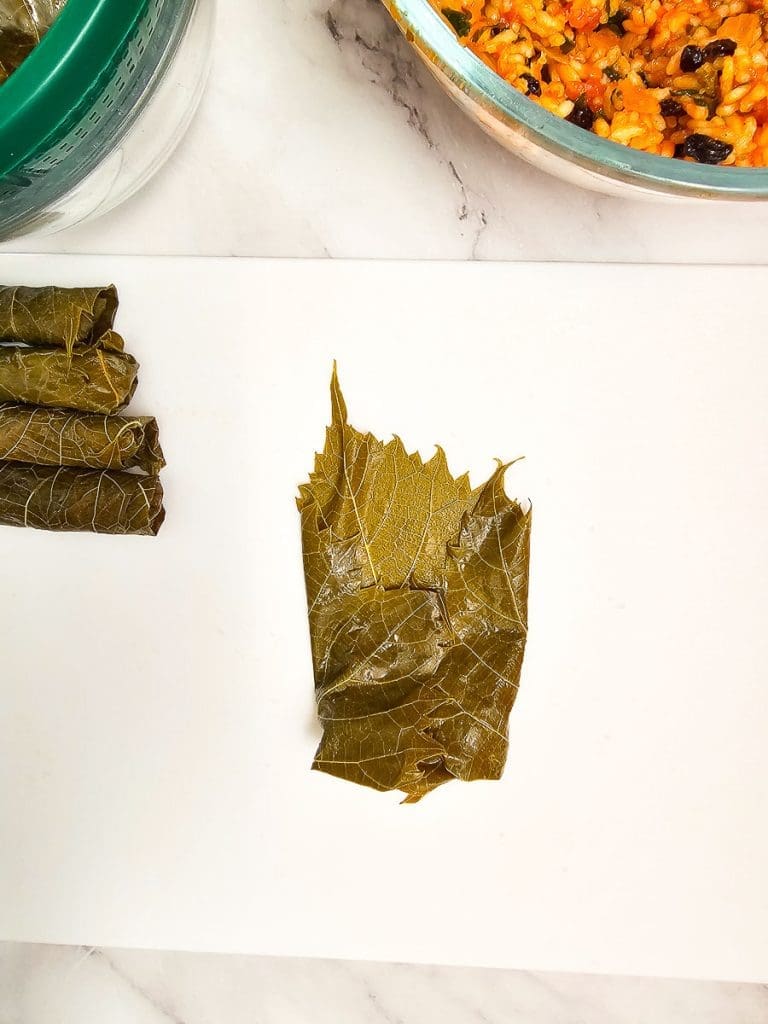
6. Bring the two sides of the leaf in towards the centre.
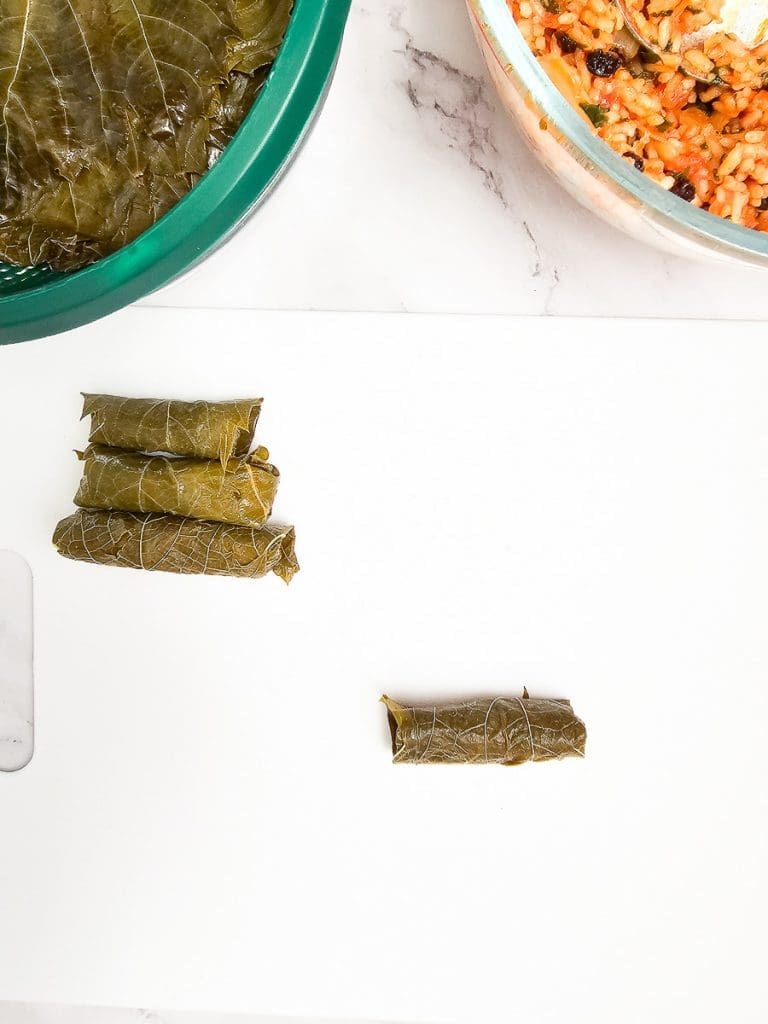
7. Roll them up tightly.
Tips for making Greek Stuffed Tomatoes with Rice (Yemista)
Soak the potatoes
I like to soak my potatoes before baking for about 15-30 minutes, or until needed. Soaking the potatoes removes excess surface starch in the potatoes which helps to make them crispier when you bake them. Soaking the potatoes also helps to prevent them from sticking together when baked. Additionally, soaking allows the potatoes to soak up moisture, resulting in a fluffy and more evenly-cooked interior.
Rinse and soak the rice
This is particularly important for Yemista, where you want the rice grains to remain separate and fluffy. To prepare the rice, place it in a bowl, cover it with water, and gently agitate it with your hands. Drain the water and repeat this process until the water runs clear, indicating that most of the surface starch has been removed. After rinsing, let the rice soak in fresh water for about 15 minutes. This step ensures the rice absorbs just the right amount of moisture, helping it cook evenly and remain tender when baked inside the vegetables
Stuff other vegetables
You can also stuff any colour capsicum/bell peppers, (but keep in mind, the green ones aren’t as sweet as the others, but are still nice to use), eggplant, and light green zucchini. Make sure you choose vegetables that are a little wider, as they are easier to fill.
Converting whole leaf herbs to chopped herbs
A helpful guideline for converting whole leaf herbs to chopped measurements is to double the amount of whole herbs to get the chopped equivalent. For example, if a recipe calls for 1/4 cup of chopped fresh herbs, start with 1/2 cup of whole, unchopped herbs. When measuring whole herbs, loosely pack them into the measuring cup. This means placing the herbs in the cup without pressing them down too firmly.
Can I prepare this recipe ahead of time?
Yes, you can partially prepare Yemista ahead of time to save time on the day of serving. Here are some steps you can take:
- Prepare the tomatoes: Scoop out the tomato flesh and set aside. Store the tomatoes in the baking dish or an airtight container until you are ready to stuff and bake them.
- Prepare the filling: Prepare the filling mixture in advance. Let the filling cool slightly before refrigerating it in an airtight container.
- Prepare the sauce: Mix all the ingredients together for the sauce. Store in an airtight container. Cover and refrigerate.
Alternatively, you can stuff the tomatoes, place them in a baking dish and cover. Store the tomato sauce in a separate container. The potatoes can be peeled and cut into wedges, covered with water, and stored in a container. If you are using a ceramic or glass baking dish, let the dish warm up in the oven during preheating, as these materials can crack if exposed to rapid temperature changes. Another option is to use a metal baking dish, which is less likely to crack due to temperature changes.
What to serve with Yemista
Incorporating potatoes into this dish elevates Yemista into a wholesome and filling dinner. Pair it with olives, some of your favourite crusty bread to soak up the rich tomato juices, and perhaps some feta if you like. Personally, I enjoy serving Yemista with a dollop of Greek full-cream yoghurt or Tzatziki (Greek Yoghurt Dip).
Storage
This dish is one of those that tastes just as good (if not better) the next day, as the flavours are melded into the stuffed tomatoes. Leftover stuffed tomatoes will keep well in the fridge for about 3 to 4 days.

